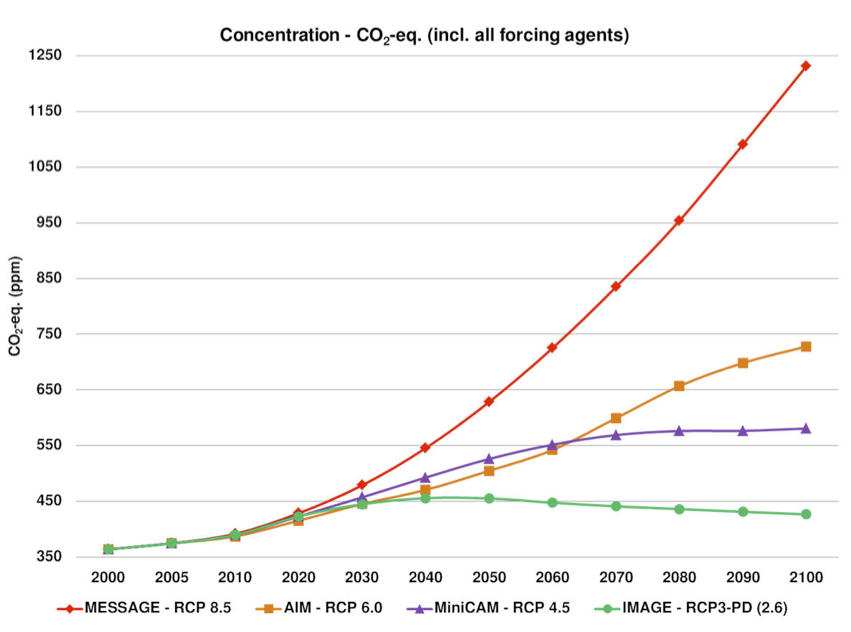|
|
Model
|
Institution
|
Resolution,
Lat x
Long ¡
|
Reference
|
|
1
|
BCC-CSM 1.1
|
Beijing Climate Center, China Meteorological Administration
|
2.8125 x 2.8125
|
Wu T (2012).
A Mass-Flux Cumulus Parameterization Scheme for Largescale Models:
Description and Test with Observations. Clim. Dynam. 38, 725–744
|
|
2
|
BCC-CSM 1.1(m)
|
Beijing Climate Center, China Meteorological Administration
|
2.8125 x 2.8125
|
Wu T (2012).
A Mass-Flux Cumulus Parameterization Scheme for Largescale Models:
Description and Test with Observations. Clim. Dynam. 38, 725–744
|
|
3
|
CSIRO-Mk3.6.0
|
Commonwealth Scientific and Industrial Research Organisation and the
Queensland Climate Change Centre of Excellence
|
1.875 x 1.875
|
Collier MA et al. (2011) The CSIROMk3.6.0 Atmosphere-Ocean
GCM: participation in CMIP5 and data publication. MODSIM 2011, Perth,
12–16 December 2011
|
|
4
|
FIO-ESM
|
The First Institute of Oceanography, SOA, China
|
2.812 x 2.812
|
Song Z, Qiao F, Song Y (2012). Response of the
equatorial basin-wide SST to wave mixing in a climate model: An amendment to
tropical bias, J. Geophys. Res., 117, C00J26
|
|
5
|
GFDL-CM3
|
Geophysical Fluid Dynamics Laboratory
|
2.0 x 2.5
|
Donner LJ et al. (2011). The dynamical core, physical
parameterizations, and basic simulation characteristics of the atmospheric
component AM3 of the GFDL Global Coupled Model CM3. Journal of Climate,
24(13).
|
|
6
|
GFDL-ESM2G
|
Geophysical Fluid Dynamics Laboratory
|
2.0 x 2.5
|
Dunne JP et al. (2012). GFDLÕs ESM2 Global Coupled
Climate–Carbon Earth System Models. Part I: Physical Formulation and
Baseline Simulation Characteristics. J. Climate, 25, 6646–6665.
|
|
7
|
GFDL-ESM2M
|
Geophysical Fluid Dynamics Laboratory
|
2.0 x 2.5
|
Dunne JP et al. (2012). GFDLÕs ESM2 Global Coupled
Climate–Carbon Earth System Models. Part I: Physical Formulation and
Baseline Simulation Characteristics. J. Climate, 25, 6646–6665.
|
|
8
|
GISS-E2-H
|
NASA Goddard Institute for Space Studies
|
2.0 x 2.5
|
Schmidt GA et al. (2006). Present day atmospheric simulations
using GISS ModelE: Comparison to in-situ, satellite and reanalysis data. J.
Climate 19, 153-192.
|
|
9
|
GISS-E2-R
|
NASA Goddard Institute for Space Studies
|
2.0 x 2.5
|
Schmidt GA et al. (2006). Present day atmospheric simulations
using GISS ModelE: Comparison to in-situ, satellite and reanalysis data. J.
Climate 19, 153-192.
|
|
10
|
HadGEM2-ES
|
Met Office Hadley Centre
|
1.2414 x 1.875
|
Collins WJ et al. (2011). Development and evaluation of
an Earth-System model-HadGEM2. GMD 4(4):1051–1075.
|
|
11
|
IPSL-CM5A-LR
|
Institut Pierre-Simon Laplace
|
1.875 x 3.75
|
Dufresne JL et al. (2013). Climate change projections
using the IPSL-CM5 Earth System Model: from CMIP3 to CMIP5. Climate Dynamics,
1-43.
|
|
12
|
IPSL-CM5A-MR
|
Institut Pierre-Simon Laplace
|
1.2587 x 2.5
|
Dufresne JL et al. (2013). Climate change projections
using the IPSL-CM5 Earth System Model: from CMIP3 to CMIP5. Climate Dynamics,
1-43.
|
|
13
|
MIROC-ESM
|
Atmosphere and Ocean Research Institute (The University of Tokyo),
National Institute for Environmental Studies, and Japan Agency for
Marine-Earth Science and Technology
|
2.8125 x 2.8125
|
Watanabe S et al. (2011). MIROC-ESM2010: model
description and basic results of CMIP5-20c3m experiments. Geoscientific Model
Development 4 (4), 845–872.
|
|
14
|
MIROC-ESM-CHEM
|
Atmosphere and Ocean Research Institute (The University of Tokyo),
National Institute for Environmental Studies, and Japan Agency for
Marine-Earth Science and Technology
|
2.8125 x 2.8125
|
Watanabe S et al. (2011). MIROC-ESM2010: model
description and basic results of CMIP5-20c3m experiments. Geoscientific Model
Development 4 (4), 845–872.
|
|
15
|
MIROC5
|
Japan Agency for Marine-Earth Science and Technology, Atmosphere and
Ocean Research Institute (The University of Tokyo), and National Institute
for Environmental Studies
|
1.4063 x 1.4063
|
Watanabe M et al. (2010). Improved Climate Simulation by
MIROC5: Mean States, Variability, and Climate Sensitivity. J. Climate, 23,
6312–6335.
|
|
16
|
MRI-CGCM3
|
Meteorological Research Institute
|
1.125 x 1.125
|
Yukimoto S (2012).
A new global climate model of Meteorological Research Institute:
MRI-CGCM3 – Model description and basic performance. J. Meteorol. Soc.
Jpn., 90a, 23–64
|
|
17
|
NorESM1-M
|
Norwegian Climate Centre
|
1.875 x 2.5
|
Kirkevag A, Iversen T, Seland O, Debernard JB, Storelvmo
T, Kristjansson JE (2008) Aerosol-cloud-climate interactions in the climate
model CAM-Oslo.Tellus A 60(3):492–512.
Seland O, Iversen T, Kirkevag A, Storelvmo T (2008).
Aerosol-climate interactions in the CAM-Oslo atmospheric GCM and
investigation of associated basic shortcomings. Tellus A 60(3):459–491.
|
